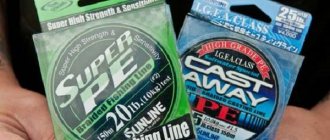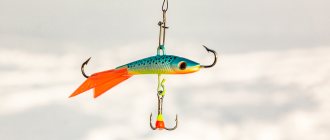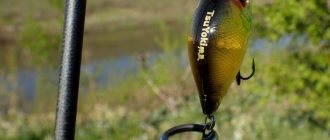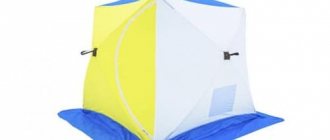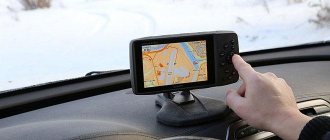With the advent of a large number of boats and yachts owned by the population, trolling fishing began to gain popularity.
Trolling is a type of fishing using a spinning rod using wobblers or spoons as bait from a floating motor boat or motorboat.
They catch salmon, pike, pike perch, catfish, etc. by trolling, mainly active fish, ready to chase and attack prey.
This is primarily sea fishing, and fishing on large rivers and reservoirs. The advantage of trolling is that it is possible to fish a large area, find the habitat of predatory fish and use several rods for these purposes at once.
If you are fishing on a river or lake, then by trolling you can initially carry out reconnaissance, find where the fish is currently located, and then start catching it with an ordinary spinning rod, as they say “casting”.
Since the conditions of such fishing differ significantly from ordinary fishing, you should pay attention to the selection of gear that is most suitable for such a dynamic load.
Monofilament line
One of the main undeniable qualities of monofilament fishing line is that the elongation will be significantly
help with fishing and dampen dynamic jerks. Since trolling is often used to catch aggressive fish that are ready to catch up with the bait, the bite will be quite tough. The stretchability of the monofilament will play a positive role.
The price of monofilament fishing line is less, and this is especially true for trolling. After all, there are several fishing rods attached to the boat (8 - 10 pieces), each will require at least 300 meters of fishing line, and this will significantly affect the budget. Even if you fish with only 3 - 4 spinning rods and attach about 200 meters of fishing line, it’s still a lot.
Choosing the diameter for
monofilament, you should focus on the range of 0.35 -0.4 mm. A fishing line thicker than 0.5 will prevent the bait from playing. But the choice of diameter will also be influenced by the current, where it is stronger it will be higher.
The use of trolling gear involves the use of plastic clothespins, which wear out faster when using braided lines.
Trolling line
Forget about braids and 100 meter unwinds. In fact, the figure of 1000 m is quite underestimated. In the last decade, several types of modern fishing lines made from advanced materials with increased strength have appeared, and anglers have begun to pay more and more attention to this element of equipment. The fishing line is essentially the only thing that connects you and the fish after the bite. No matter what the boat and motor are, no matter how expensive the trolling reel and super-powerful trolling rod, all this will remain unusable if you do not pay due attention to the fishing line.
Braid is not used in trolling, since the cord quickly wears out the plastic clothespins with which it constantly comes into contact during fishing, and thus increases the already significant costs. But another reason is more important, which lies in the nature of the salmon fish bites. By the way, the bites of both large pike and pike perch can be very tough. Rigidity greatly enhances the boat's movement. When an angler stands still, moving the bait at a speed of 1-3 km/h, this is one thing. But the predator first has to catch up with the bait, then attack the spoon (or wobbler) moving at a speed of 4-7 km/h. Moreover, after the bite, without reducing the speed, the fish on the rig is pulled further. The rod does not help in such a situation, and the main load falls on the friction and fishing line. The entire tackle as a whole is under enormous stress. This can be better understood when you watch a Baltic salmon attacking a bait on a video filmed underwater with a camera mounted on a line above the bait. The clutch, no matter how perfect the coil, operates with a delay. Therefore, first of all, the efforts of the fish are dampened by the fishing line. An inextensible cord causes constant breaks and fish escapes. The predator's mouth is too weak, and a sharp jerk simply pulls the spoon out of it. For this reason, the clutch should be adjusted as sensitively as possible.
Read: Braided line for spinning: types and rules of choice
The diameter of the fishing line used is most often about 0.4 mm. It is very rare to choose 0.35 mm, but you should not use more than 0.5 mm either. Strength is strength, but we must not forget about the work of the bait, which a thick fishing line will not allow to play properly.
Arithmetic is a serious science. Let me remind you that the number of gear involved is 14 and each one has at least 200 m of fishing line. With a simple action we get a figure of 3 (!) km. In monetary terms, taking 200 rubles as a basis. for 100 m of good fishing line, we get the figure 6000 rubles. Not as serious as with coils, but still. Fortunately, in addition to the usual reels unwinding 100-200 m long, specialized trolling stores sell massive reels with unwinding lengths of several kilometers.
I use Stroft line all the time and don't want to change anything. Many anglers choose other brands from Japanese, Scandinavian and North American manufacturers. But they are united by an approximately equal cost level of 200-300 rubles. for 100 m.
When purchasing fishing line, do not forget about the strategic reserve. When we talk about 200 m required for fishing, this means that this amount should always be on the spool, which means it’s not superfluous to make a reserve of 50 m. And it’s worth changing the fishing line from time to time. Fishing line is the main consumable material, for this reason a reserve of at least 400-500 m is required. Currently, fishing line is also produced with the troll mark, which means that it is designed specifically for trolling. It initially contains an increased breaking load, especially at the knots, and the elongation is at an average level (too hard will not work, but too much elongation will also cause a number of inconveniences during fishing). An important property is the lack of memory. Memory is a real scourge, killing hundreds of meters of fishing line in one fishing trip. The reason is simple: when using high-amplitude lures, especially in combination with a flasher or dodger, the line twists at incredible speed. Two or three days of intense fishing and a 30 m long section is completely out of order. This cannot be avoided; you can only reduce the twisting effect by using additional swivels and fishing line with less memory.
Subscribe to
our channel in Yandex Zen
Braided cord
Proponents of braided line also find many arguments for its use in trolling.
If you choose a braided cord, it should not be super thin. If the wobbler catches well on an obstacle at the bottom, add here the tension created by the movement of the boat, the thin braid will break faster.
The choice of braided line size will be influenced by the task you are trying to solve, or rather what kind of fish you are targeting, but the choice will be in favor of a thicker diameter. With regard to braid, this diameter will be in the range of 0.19-0.23, although in braid it is always better to focus on the breaking load and it should be at least 10 kg.
If you manage to avoid snags, then in principle the service life of the braid will be much longer.
At the same time, the thin braid will, according to the law of physics, be pushed out by water; the wobbler will not be able to sink deep enough.
You need to buy trolling line immediately in a large unwind. An unwinding of 50 or 100 meters would be inappropriate in this case.
Regardless of what fishing line you use, make it a rule to inspect it before each fishing trip for abrasions or mechanical damage.
What kind of tackle should you use for trolling?
Once your boat is equipped with everything necessary to fight river or sea predators, you should think about choosing trolling gear. The conditions and nature of trolling fishing leaves a certain imprint not only on the choice of boat, engine and equipment. Selecting the right spinning rod for trolling is the most important point that must be approached with all responsibility.
You need to start assembling a spinning rod for trolling from the rod itself. It is worth understanding that, unlike a conventional casting spinning rod, the lightness and aesthetics of the tackle, casting range and accuracy, as well as test and action are not so important for trolling spinning rods. Although the latter parameters are still worth paying attention to, more on that later. The main characteristics are power and indestructibility.
A high-quality troll rod usually has a reinforced butt, powerful guides and reel mounts. Test characteristics are usually expressed in terms of the diameter of the cord (line) that can be used with a given rod. The average range of line diameters for fresh water is 0.14-0.20, and for sea or targeted catfish fishing from 0.17 to 0.4 or more. A generally accepted and understandable test for such a rod will be in the range from 40 to 150 grams or more. The larger the bait and the strength of the current, the more powerful the rod should be. In short, a no-frills, austere, powerful stick that can hold off the powerful jerks of big fish.
A few words about the structure of the spinning rod for trolling. Usually fairly fast rods are used, but without fanaticism. It is very important to catch the line here. Excessively fast spinning rods will deprive your tackle of elasticity. There will be frequent derailments and loss of baits on the hooks, especially if you miss with the clutch. At the same time, an excessively whippy spinning rod will bend in an arc under the weight of additional equipment and heavy baits. Which is also not good.
The length of the rods ranges from 1.90 to 3.50 meters. The average optimal option, according to the general opinion of many trollers, is a spinning rod length of 2-2.5 meters. It is worth using rods of different lengths. One for close combat with a length of 2 meters, the second for long distances up to 3 meters. This will give you an advantage in maneuverability and convenience. Among the manufacturers of good troll sticks, it is worth noting Salmo, Daiwa, Balzer and others. In any case, it’s better to shake the wand before buying - don’t buy at random.
The rod has been selected. The next most important element of gear, on which the fishing result will largely depend, is a trolling reel . All adherents of casting gear should forget about meat grinders when choosing a reel for trolling gear. Based on the tasks that a good trolling reel should perform, you should opt for a high-quality multiplier.
A trolling reel must have the following qualities:
- Sturdy and reliable design without excess. Reliability comes first. Conditions in trolling are a priori more difficult than fishing from the shore.
- The reel must withstand a constant load on the spool, friction brake and other structural elements. The tackle is constantly under tension.
- Fine-tuning the clutch. The bait should not unwind the line from the spool, but at the same time, even a small fish should freely pull the line from the reel.
- Large supply of fishing line (cord) on the spool. It's clear here. The water areas are large and the predators are powerful.
- The ability to withstand and smooth out sharp jerks of fish and bait hooks. So as not to break the tackle and lose the trophy.
- It is advisable that the reel be equipped with a sensor for the amount of cord discarded. It is very convenient to control at what distance from the boat and at what depth the bait is going.
As you can easily guess, not a single inertia-free reel will score even three points out of six. That’s why we definitely choose a multiplier! Not for the sake of advertising, but from my own experience, I will note that Abu Garcia and Daiwa baitcasting reels have proven themselves to be excellent. For example, the Ambassadeur series from Abu or Daiwa T3 Ballistic.
After the reels have been purchased and installed on the fishing rod, a pressing question arises for the beginning troller: “Should I use cord or fishing line for trolling gear ?”
There is no clear opinion, and therefore no answer. We will not claim the ultimate truth, we will simply note the disadvantages and advantages of fishing line and cord. And drawing conclusions is the destiny of each individual fisherman.
So, fishermen who advocate fishing line motivate this by the fact that -
- The fishing line is stretchable, but the cord is not. It follows from this that if the tackle is equipped with a cord, then there will be frequent fish runs and bait breaks, since only the stretch that is inherent in the fishing line will absorb the initial impulse from a jerk or hook. Strictly speaking, the line will not be able to absorb the efforts of the fish as effectively as the fishing line will.
- Underwater obstacles, sand, shell rock, as well as parts of the equipment that are attached to clips, subject the fishing line to much less wear and tear than the cord.
- The line is less noticeable in the water, which means it doesn’t scare away the fish as much.
- The average price of fishing line is less than that of a good cord.
Cord supporters, in turn, insist:
- The fishing line is stretchable, but the cord is not, which is ridiculously an advantage. The cord allows you to react more clearly and quickly to fish bites, especially at a far distance from the boat.
- With the same diameter as the fishing line, the cord is certainly many times stronger
- Many modern cords are much more resistant to abrasion than fishing line.
- The cord does not twist as much as the fishing line. Especially when using dodgers, flashers and spinners.
- With the cord you can (as with fishing line in principle) use a fluorocarbon leader.
Everyone's personal opinion is where to stop. There is also a fishing line and a cord. Try, experiment, and you will find the ideal option specifically for your fishing conditions.
We note only general points that need to be taken into account. The breaking load and, accordingly, the diameter of the cord (line) must correspond to the gear, in general, and the reel separately. These parameters are indicated on both the trolling rod and the multiplier. There is no need to invent anything here, the manufacturer knows better than us.
The thread supply should be large enough. 150 meters on rivers and lakes and up to 300 meters for sea fishing.
The gear is almost ready. There's just a little bit left to do. Select accessories (carabiners, swivels, clasps, knotless ones) and a leash for trolling . Often, anglers pay little attention to this cheapest element of equipment. And then it’s excruciatingly painful to watch as a trophy predator unbends a poor-quality fastener or tears the leash into rags.
The advice is as simple as it is perfect. Use high-quality fittings from well-known manufacturers. The power characteristics of which will not be inferior to other elements of the gear. This advice is especially relevant for trolling gear, where there are no small details. There simply shouldn't be any weak links!
If the hooks are on baits, then only high-quality Japanese Owner, Decoy.
The snap hooks, swivels, and winding rings are all the same Owner or at worst VMC.
Materials for leashes are either durable, high-quality fluorocarbon with a diameter of 0.4-0.8 mm, depending on the size of the intended predator. Or from leash materials, of which there are a great variety on the market now. The main thing is to compare the total breaking load of the leash with the strength of the main gear.
The length of the leash should be two meters. This is enough to protect the main tackle from damage to the bottom and from toothy pike.
Now you are almost ready to go into battle with a trophy predator. The boat is equipped with the latest technology, the gear is assembled and placed in fasteners, all that remains is to assemble the first box of bait and you can hit the road. But we’ll talk about baits in the next article.
Line counter
In order to determine the depth of the wobbler, you need to know how much fishing line to unwind, and with a 300-meter length this can only be done using a counter.
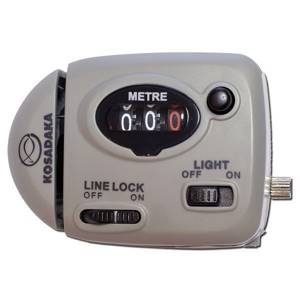
This device is installed on a fishing rod only with a baitcasting reel.
It works simply: the fishing line passes through the roller and the device shows its quantity. Then, with a simple press of a button, the numbers are reset to zero. Here are some models of such counters:
- Rapala RLLC – illuminated.
- TLC1 (Kosadaka) – the counter is backlit.
- Salmo.
- Shakespeare ALPHA.
Number of fishing line
The amount of fishing line released when trolling should be exactly enough so that the bait, wobbler, goes at the depth you need.
A shorter length will pull the bait into the upper layers of the reservoir and even deepeners will not be able to lower it to the desired horizon. At the same time, the excess will create windage and, paradoxically, the line with the bait will also go up.
The amount of fishing line will depend on the speed of the boat and will be different each time, determined experimentally on each fishing trip.
